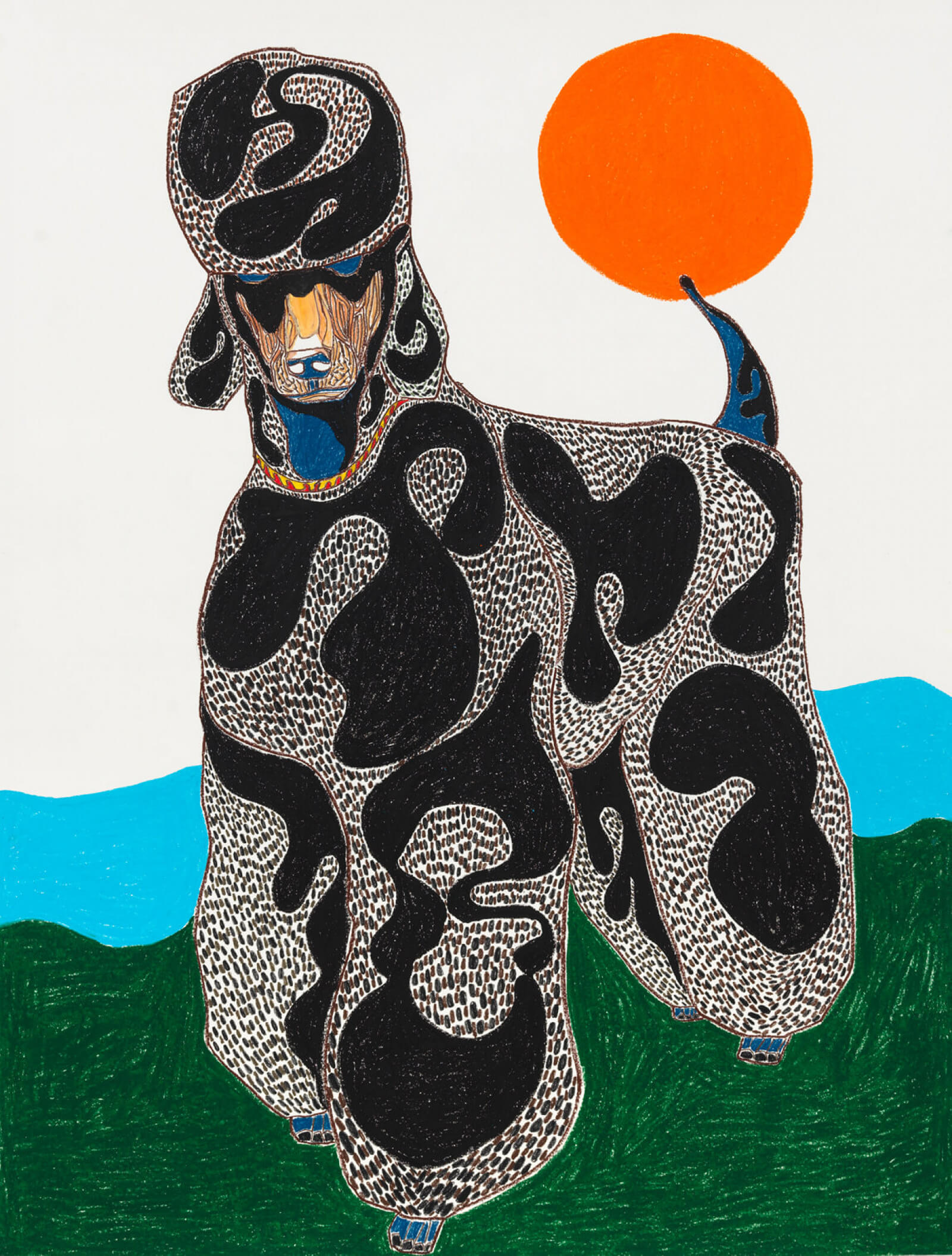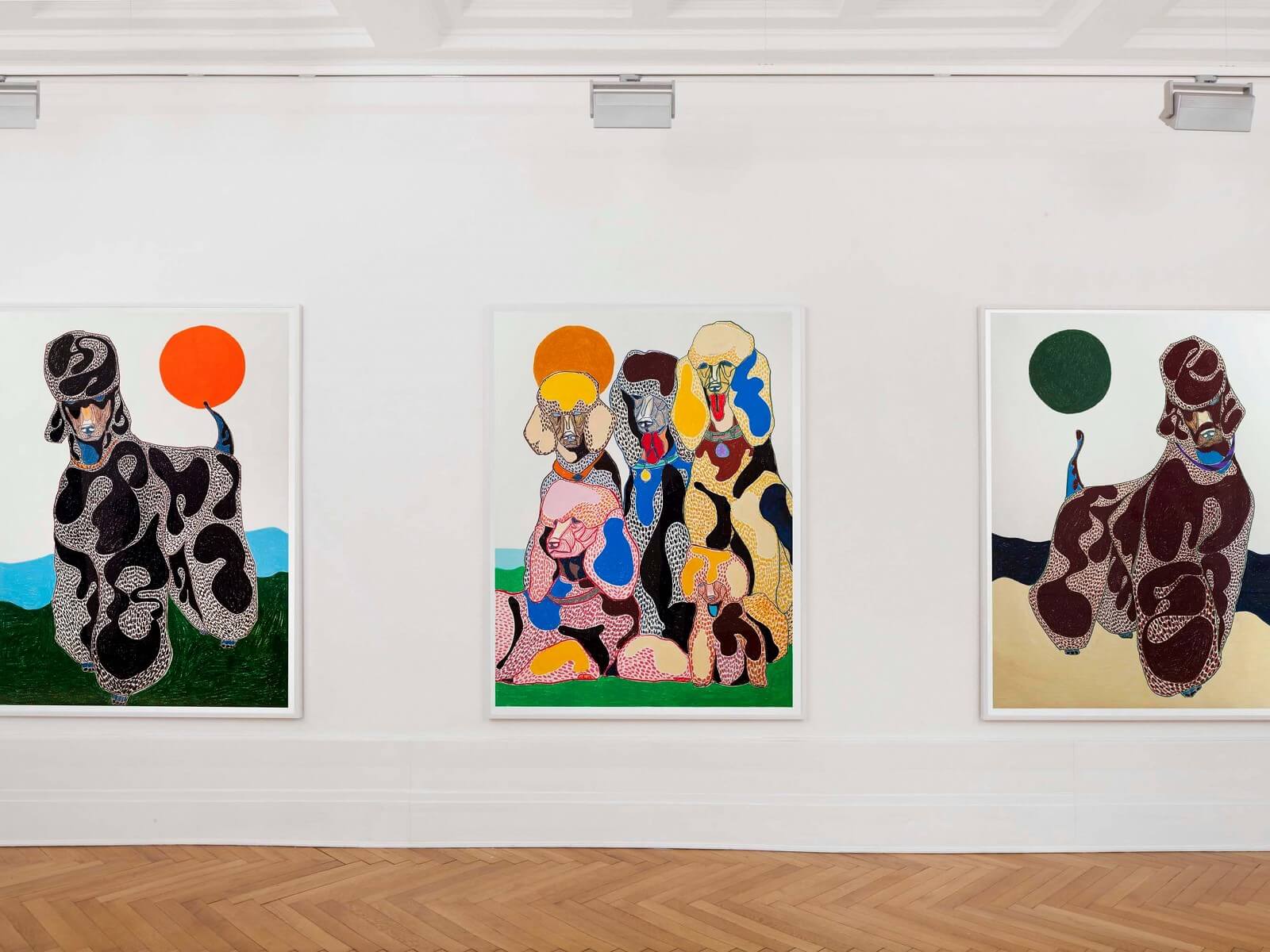Susumu Kamijo
I'll Follow You To The Sunset
➝ German Press Release
➝ Download Press Release
For about three years now, Susumu Kamijo has been creating pictures of poodles. These colourful, fluffy four-legged creatures have long been a kind of personal trademark, immediately recognisable. Recurring elements – landscapes suggested by a horizon, or the circular shape in the background that may be interpreted as the sun or the moon, depending on its colour – mean that these portrait format pieces can be seen as a series. But the sense of sequence contrasts with the specific characteristics of the poodles depicted. The different body postures and detailed facial expressions of each animal confer a distinct personality on every individual image. Whether they’re in a group, standing alone or understood to be interacting with a human, some seem playful, others somewhat goofy and others as quite proud, even. It is in the repetition that the differences between individual images initially become especially apparent. Kamijo thus succeeds in this series in becoming the dogs’ portraitist.
For him, it is less about the animal being depicted itself than its form. What motivated Kamijo to choose poodles as the subject of his art was the peculiar shapes of their bodies – particularly those that are clipped and coiffed. Since this discovery, which he made one day whilst out walking his girlfriend’s dog, Kamijo has used photographs from dog shows or magazines as inspiration for his drawings, meticulously selecting the ones he wishes to use as models for his own work. Kamijo has always been fascinated by the fundamental elements of shape and colour in all images. With the poodles his aim now is to exploit these elements to their full potential. Guided by this aspiration, a tension between figurative and more abstract emerges as integral to his artistic practice.
One of Kamijo’s major influences from art history is his passion for the German Expressionists. They created impactful images with the heavy application of opaque, vibrant and even dark colours. And (whether he intends it or not) parallels with his source of inspiration can indeed be found in Kamijo’s work. The first to strike the viewer is the contrasting constellations of colours. The rough execution of lines and flat blocks of colour are also reminiscent of the woodcut style that was rediscovered at that time. But more evocative of Expressionism than anything is how Kamijo’s work balances the abstract and the figurative. Despite the hyper realistic intensity of the image, its relation to its subject and to reality remains intact, keeping viewers grounded amidst the dynamic impact of colour and shape: it is, after all, entirely clear that what is being depicted is poodles. Yet if you focus on individual sections, they appear to break up into dots and short lines. And Kamijo’s conscious choice of paper and pastels also gives his pictures their very own texture and feel, further accentuating the abstract elements. It makes patterned surfaces, for example, seem dynamic and turbulent. And as for the vibrant colours, rather than playing down the somewhat banal subject, they form an exciting contrast with a rich black that, depending on how it is employed, either brings a sense of solidity to the image or adds to its dynamism. Kamijo’s poodles are so much more than the animals they depict. They are vibrant constellations of stimulating colours and shapes, hybrids between portrait and abstract art that command the attention of anyone who sees them.
by Klara Niemann

Additional Information

Since 2014, Susumu Kamijo has been working on a series of colorful drawing depicting poodles, something that has become a sort of the artist’s trademark. His continuous meditation on the forms of the dogs, though, renders many variations. No drawing is the same. Sometimes, the level of detail he attributes to, say, a ear, or a dog’s hair, touches on abstraction — the dog emerging as a puppy or as a menacing and sensuous creature.
Living currently in Brooklyn, Susumo Kamijo is originally from Nagano, Japan. Born in 1975, he moved to the United States when he was 16. There, he completed his BFA in Painting and Drawing at the University of Oregon in 2000, followed by an MFA in Painting and Drawing at the University of Washington in 2002.
